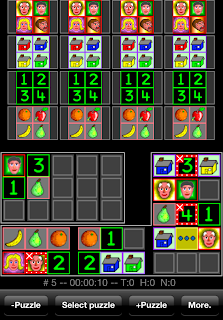There are actually three version on the App Store:
Sherlock, The Game of Logic (Free) which contains 30 puzzles. A single $2.99 in-app purchase unlocks 150,000 (!) puzzles;
Sherlock PRO ($0.99) which contains 600 puzzles;
Sherlock ULTRA ($3.99) which contains 7,500 puzzles.
To add complexity to the choice, the PRO and ULTRA versions run natively on iPad, while the Free version is designed only for iPhone.
The fact that the PC version is sold for $19.95, tells a lot about the impact of the App Store on the software industry.
Starting from the title screen, the low resolution graphics scream "I'm a Windows 95 game".
After starting the game, it's clear that this is a logic deduction puzzle in the vein of puzzle grids; however, it's quite obscure what you are supposed to do.
Unfortunately the Help button systematically crashes on my iPod, so I couldn't get guidance from that, but here is how I think it works:
The top half of the screen is where you have to build the solution; the bottom half contains the clues. The clues can be moved around for no apparent reason, and can be hidden by tapping on them when you don't need them anymore.
The meaning of the clues is the fun part.
1) the 3 and the Pear are in the same column (this is the only intuitive one).
2) the Blue and Yellow houses are exactly two columns apart, but we don't know which one is on the left and which one is on the right. Also, the 3 is not in the column inbetween.
3) the Banana, Pear, and Orange are in three consecutive columns and the Pear is in the middle, but we don't know whether the Banana is on the left or on the right.
4) the Orange and 1 are in two consecutive columns, but we don't know which one is on the left and which one is on the right.
5) the Blue house is on the left of the Yellow face.
Once you understand the above, solving the puzzles requires straightforward elimination of possibilities; for example, because of 1), the Pear cannot be in the first or last column.
To eliminate possibilities, you tap on the columns to zoom in, then tap the item you want to exclude. To exclude all items except one, you tap and hold the one you want to keep.
In the end, you should be left with the solution:
The puzzles are available in three sizes, from 4x4 to 6x6. 6x6 feels a bit crammed on the iPhone screen, surely it should play better on iPad.
I think this game desperately needs a designer to make the interface clearer. At the moment, figuring out the rules is a puzzle in itself, and the user interface has way too many buttons and options.
Also, the graphics look 20 years old (and probably are).
The solving process is enjoyable but, despite the complexity of the clue system, feels somewhat mechanical. Would I want to solve 150,000 of these puzzles? Probably not.
Summary
| Nontrivialness | ★★★☆☆ |
| Logical Reasoning | ★★★★☆ |
| User Interface | ★☆☆☆☆ |
| Presentation | ★☆☆☆☆ |
| Loading Time | ★★★★★ |
| Saves Partial Progress | ✔ |
| Status Bar | ✔ |
©2013 Nicola Salmoria. Unauthorized use and/or duplication without express and written permission is strictly prohibited. Excerpts and links may be used, provided that full and clear credit is given to Nicola Salmoria and nontrivialgames.blogspot.com with appropriate and specific direction to the original content.





